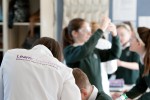This Spring term (for Northern Hemisphere readers) we are showcasing and promoting some of the many ways chemisry teachers can enhance their teaching with tools and resources that support a flexible, multi-platform approach.
This is often described as BYOD, or 'Bring Your Own Device'. I think this is something of a misnomer, and centres attention on the hardware, rather than the myriad software tools and resources designed to be device-agnostic. To support this theme, we commissioned Peter Banks, MRSC, secretary of the Royal Society of Chemistry's Education Techniques Group, and webmaster of
chemstuff, to write about applying a BYOD method to chemistry teaching.
I'm proud to provide, below, the first of a two-part post on BYOD in chemistry teaching from Peter Banks.
Using multi-platform tools to support chemistry teaching. Part 1 - introduction.
Peter Banks
‘BYOD’ - What is it?
The interminable battle between teacher and pupil to get them to put their phone away, and not to text their mates under the table during lessons, is likely to be one which will continue forever. However, if they want to use their phones, why not harness that energy and put it to good use?
Since being asked to write this, I’ve been asking my fellow teachers about what their advice (if any) would be, when getting pupils to use their own devices. Their response is generally “don’t!” I think this is a shame.
I have found that a mobile phone can be an inspiring tool which supports engagement within lessons and encourages learning. Pupils certainly learn better when they are enjoying their learning. If they have fun using their own devices then it is a technique worth using in the classroom.
There are some real benefits to pupils bringing their own device:
-
First, the pupil will probably have a very good knowledge of how to navigate through their own apps.
-
Second, if the pupil is finding out about chemistry on their own device, they will be much more likely to find the websites again, as the device’s history will include any sites they visited whilst carrying out your task. They could even bookmark sites for use later for their own private study. Pupils with SEN often have their own accessibility packages or settings and therefore can use their own software to support their own learning further.
Potential Pitfalls
Every pupil is likely to have a different type of device: Android, laptop, Chromebook, iPhone or tablet. Everyone will have a different mobile provider, some might not have internet access and some may not be able to access various types of content or apps. These are a variety of the challenges that you might face. However, these can often be overcome for many tasks.
It is of course possible that pupils may take the opportunity to waste time or play on their mobiles, making sure that there are some ground rules usually helps. You will know your classes and where this could or won’t work. It might not be suitable to use this in every scenario, but I think it is often worth a try.
Apps are the most usual pitfall in the ‘bring your own device’ concept and can create difficulty when looking for cross platform ideas. Larger app producers (google, dropbox, quizlet etc) are very likely to have apps for most devices.
If you are looking for an app which performs a specific function (eg stop frame animation) even the less technically savvy pupils can usually search and find something which will do the job with some success. If there’s difficulty, try grouping pupils with working devices together with those who are without, or getting pupils to suggest apps.
As with any strategy it is important to use this for a specific activity which supports learning, rather than using the technology for its own sake. It is important to maintain the focus on the chemistry, avoiding teaching the use of a phone or device as far as possible. I often use a tried and tested activity and add the use of a camera phone or research based task on top.
